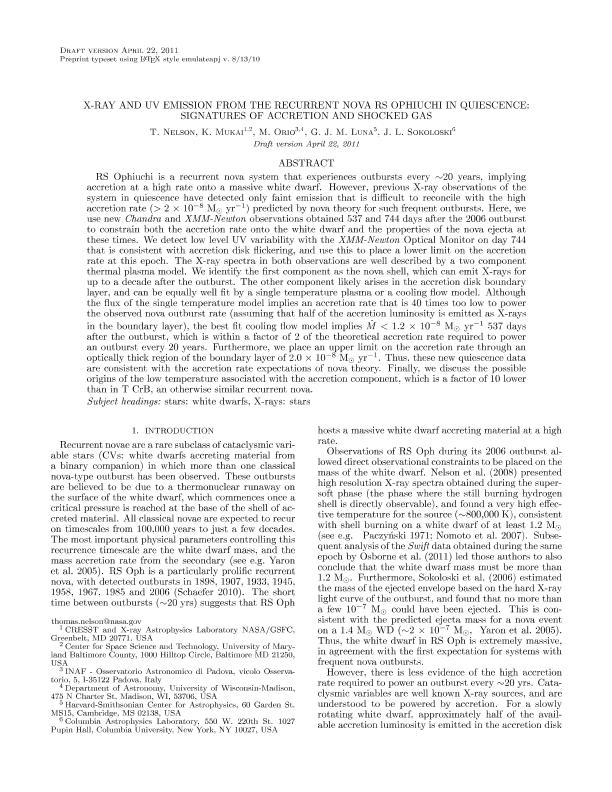Mostrar el registro sencillo del ítem
dc.contributor.author
Nelson, T.
dc.contributor.author
Mukai, K.
dc.contributor.author
Orio, M.
dc.contributor.author
Luna, Gerardo Juan Manuel

dc.contributor.author
Sokoloski, J. L.
dc.date.available
2017-02-14T15:59:32Z
dc.date.issued
2011-07
dc.identifier.citation
Nelson, T.; Mukai, K.; Orio, M.; Luna, Gerardo Juan Manuel; Sokoloski, J. L.; X-ray and ultraviolet emission from the recurrent nova rs ophiuchi in quiescence: signatures of accretion and shocked gas; Iop Publishing; Astrophysical Journal; 737; 1; 7-2011; 7-23
dc.identifier.issn
0004-637X
dc.identifier.uri
http://hdl.handle.net/11336/12970
dc.description.abstract
RS Ophiuchi is a recurrent nova system that experiences outbursts every ~20 years, implying accretion at a high rate onto a massive white dwarf. However, previous X-ray observations of the system in quiescence have detected only faint emission that is difficult to reconcile with the high accretion rate (>2 × 10–8 M yr–1) predicted by nova theory for such frequent outbursts. Here, we use new Chandra and XMM-Newton observations obtained 537 and 744 days after the 2006 outburst to constrain both the accretion rate onto the white dwarf and the properties of the nova ejecta at these times. We detect low level UV variability with the XMM-Newton Optical Monitor on day 744 that is consistent with accretion disk flickering, and use this to place a lower limit on the accretion rate at this epoch. The X-ray spectra in both observations are well described by a two component thermal plasma model. We identify the first component as the nova shell, which can emit X-rays for up to a decade after the outburst. The other component likely arises in the accretion disk boundary layer, and can be equally well fit by a single temperature plasma or a cooling flow model. Although the flux of the single temperature model implies an accretion rate that is 40 times too low to power the observed nova outburst rate (assuming that half of the accretion luminosity is emitted as X-rays in the boundary layer), the best-fit cooling flow model implies < 1.2 × 10–8 M yr–1 537 days after the outburst, which is within a factor of two of the theoretical accretion rate required to power an outburst every 20 years. Furthermore, we place an upper limit on the accretion rate through an optically thick region of the boundary layer of 2.0 × 10–8 M yr–1. Thus, these new quiescence data are consistent with the accretion rate expectations of nova theory. Finally, we discuss the possible origins of the low temperature associated with the accretion component, which is a factor of 10 lower than in T CrB, an otherwise similar recurrent nova.
dc.format
application/pdf
dc.language.iso
eng
dc.publisher
Iop Publishing

dc.rights
info:eu-repo/semantics/openAccess
dc.rights.uri
https://creativecommons.org/licenses/by-nc-sa/2.5/ar/
dc.subject
Novae, Cataclysmic Variables
dc.subject
Ultraviolet: Stars
dc.subject
White Dwarfs
dc.subject
X-Rays: Stars
dc.subject.classification
Astronomía

dc.subject.classification
Ciencias Físicas

dc.subject.classification
CIENCIAS NATURALES Y EXACTAS

dc.title
X-ray and ultraviolet emission from the recurrent nova rs ophiuchi in quiescence: signatures of accretion and shocked gas
dc.type
info:eu-repo/semantics/article
dc.type
info:ar-repo/semantics/artículo
dc.type
info:eu-repo/semantics/publishedVersion
dc.date.updated
2017-02-13T20:31:58Z
dc.journal.volume
737
dc.journal.number
1
dc.journal.pagination
7-23
dc.journal.pais
Reino Unido

dc.description.fil
Fil: Nelson, T.. National Aeronautics And Space Administration. Goddart Institute For Sapace Studies; Estados Unidos. University of Maryland; Estados Unidos. University Of Minnesota; Estados Unidos
dc.description.fil
Fil: Mukai, K.. National Aeronautics And Space Administration. Goddart Institute For Sapace Studies; Estados Unidos. University of Maryland; Estados Unidos
dc.description.fil
Fil: Orio, M.. INAF-Osservatorio Astronomico di Padova; Italia. University Of Wisconsin; Estados Unidos
dc.description.fil
Fil: Luna, Gerardo Juan Manuel. Harvard-Smithsonian Center for Astrophysics; Estados Unidos. Consejo Nacional de Investigaciones Científicas y Técnicas; Argentina
dc.description.fil
Fil: Sokoloski, J. L.. Columbia University; Estados Unidos
dc.journal.title
Astrophysical Journal

dc.relation.alternativeid
info:eu-repo/semantics/altIdentifier/url/http://iopscience.iop.org/article/10.1088/0004-637X/737/1/7/meta
dc.relation.alternativeid
info:eu-repo/semantics/altIdentifier/url/https://arxiv.org/abs/1105.2569
dc.relation.alternativeid
info:eu-repo/semantics/altIdentifier/doi/https://doi.org/10.1088/0004-637X/737/1/7
Archivos asociados
